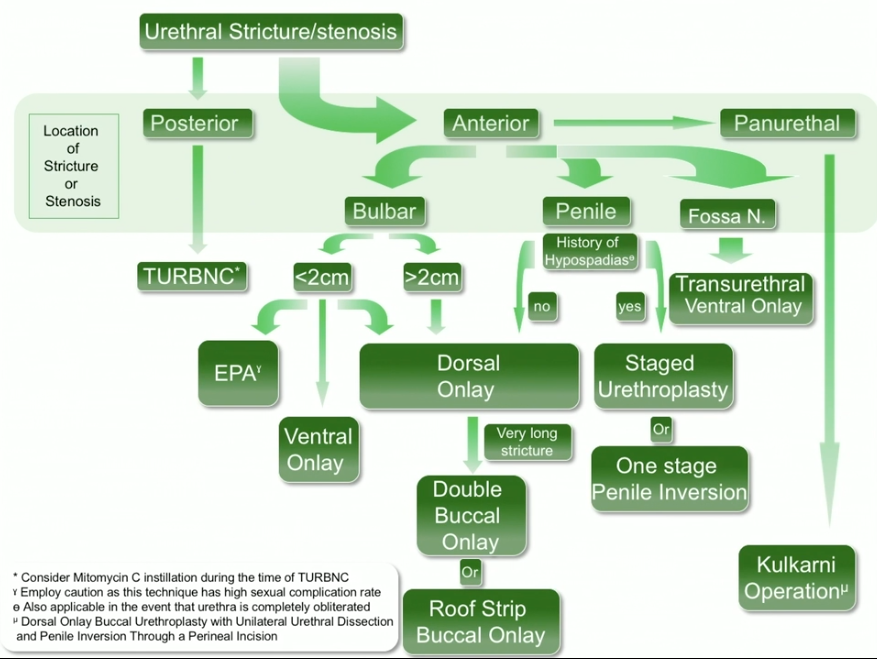Maxx Gallegos, MD, presented “Urethral Stricture Management in the 21st Century: Treatments for Even the Worst Urethras” during the 23rd Annual Innovations in Urologic Practice on September 14, 2018 in Santa Fe, New Mexico.
How to cite: Gallegos, Maxx. “Urethral Stricture Management in the 21st Century: Treatments for Even the Worst Urethras” September 14, 2018. Accessed [date today]. https://dev.grandroundsinurology.com/urethral-stricture-management-in-the-21st-century-treatments-for-even-the-worst-urethras/
Urethral Stricture Management in the 21st Century: Treatments for Even the Worst Urethras – Summary:
Maxx Gallegos, MD, reviews traditional urethral stricture management techniques, specifically direct visualization internal urethrotomy (DVIU) and dilation. He then discusses new and emerging techniques, especially urethroplasty, that may better benefit these patients.
Abstract:
With the advent of the American Urological Association (AUA) Guidelines on urethral stricture disease, urethral stricture management is likely to change (1). Historically, the management of urethral strictures has been an endoscopic approach with either DVIU or dilation. In the past, urologists generally thought these treatments had acceptable success rates (2). More contemporary data shows that endoscopic treatments for urethral strictures are not initially successful, and never successful thereafter (3).
Definitive repair via urethroplasty will likely increase in utilization with success rates between 88% and 95% (4). Selecting which type of urethroplasty to offer a patient can be difficult. Therefore, fluoroscopic, and sometimes endoscopic, preoperative evaluation is necessary (1). In the penile urethra, most experts advocate for substitution urethroplasty with buccal mucosa (1). The new technique of transurethral ventral onlay for meatal and fossa navicularis strictures has so far demonstrated durable success (5).
In the bulbar urethra, there are multiple acceptable techniques for urethral strictures less than or equal to 2cm. However, there is controversy as to which technique is most efficacious with the least complications (4). For strictures greater than 4cm in the bulbar urethra, the use of double-sided buccal grafts is very effective (6,7). For panurethral strictures, Sanjay Kulkarni, MBBS, MS, FRCS, of Pune, India has pioneered an effective technique involving the invagination of the penis through a perineal incision, a unilateral dissection of the urethra, and a dorsal onlay buccal graft (8,9). Management of this condition is evolving, with novel techniques continually emerging, to the benefit of our patients, even those with the most complex urethral strictures.
About Innovations in Urologic Practice
Innovations in Urologic Practice (IUP) is an annual CME-accredited conference devoted to updating urologists on the rapidly changing healthcare environment. Topics focus on innovative diagnostic and treatment strategies, controversies, new and currently developing technologies, and challenges in today’s urologic practice. Dr. Gallegos presented this lecture during the 23rd IUP in 2018. Please visit this page in order to learn more about future IUP meetings.
References
- Wessells H, Santucci RA, et al. Male Urethral Stricture: American Urological Association Guideline. J Urol. 2017; 197(1):182-190.
- Bullock CL, Brandes SB. Anterior urethral strictures: A national practice pattern survey of board certified urologists in the United States. J Urol. 1997; 157:98-101.
- Santucci R, Eisenberg L. Urethrotomy has a much lower success rate than previously reported. J Urol. 2010; 83:1859-62.
- Gallegos MA, Santucci RA. Advances in urethral stricture management. F1000Res. 2016; 5:2913.
- Daneshvar M, Hughes M, Nikolavsky D. Surgical management of fossa navicularis in distal urethral strictures. Curr Urol Rep. 2018; 19(6):43.
- Palminteri E, Monzoni G, Berdondini E, Di Fiore F, Testa G, Poluzzi M, Molon A. Combined dorsal plus ventral double buccal mucosa graft in bulbar urethral reconstruction. Eur Urol. 2008;53:81-9.
- Joshi P, Kaya C, Kulkarni S. Approach to bulbar urethral strictures: Which technique and when? Turk J Urol. 2016 Jun;42(2):53-59.
- Kulkarni SB, Kulkarni JY, Kirpekar DV. A new technique of urethroplasty for balanitis xerotica obliterans. J Urol. (Suppl). 2000;163:352; (abstract V331).
- Kulkarni SB, Joshi PM, Venkatesan K. Management of panurethral stricture disease in India. J Urol. 2012;188:824-830.
ABOUT THE AUTHOR
Dr. Maxx A. Gallegos is an Assistant Professor of Urology in the Department of Surgery at the University of New Mexico Health Sciences Center in Albuquerque. He also serves as the Associate Resident Program Director in the Division of Urology there. He graduated with honors from the University Of Kansas School Of Medicine in 2011. From 2016 to 2017, he worked as a reconstructive urologist at Detroit Medical Center in Michigan. In addition to his positions at UNM, Dr. Gallegos also has a private practice in Albuquerque. He is an expert in plastic surgery of the urogenital system, and his clinical interests include urethral and ureteral reconstructive surgery, genital aesthetic surgery, urologic prosthetics, genital/urinary trauma, and adolescent to adult urologic care. Dr. Gallegos is a Fellow of the Alpha Omega Alpha Honor Medical Society and a member of the American College of Surgeons.






